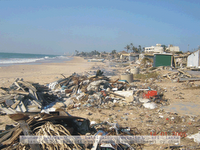According to the International Viewpoint after the tsunami disaster in the Indian Ocean of December 2004, the government of many affected countries such as Sri Lanka are not allowing rebuilding on the coast.
“No new building structures will be permitted within 100 metres of the Western coast of the island. In the Eastern coast the distance where the construction will be permitted has been extended to 200 metres. New towns will have to be built one kilometre from the coast.”
This announcement obviously upset the Sri Lankan community. To offset this decision and offer a possible solution I am proposing tsunami(resistant)housing.
Factors to consider:
low cost
modularity
expandability
ease of construcion
permability
protected safe area
modularity
expandability
ease of construcion
permability
protected safe area
The goal of tsunami(resistant)housing is to allow the tsunami waves to pass through the house by creating an open plan oriented perpendicular to the coast line.
Another idea I'm considering in creating housing resistant to tsunami force waves is the use of vegetation. According to Adam White of Soils & The Environment "The roots of the vegetation also help to reduce the likelihood of soil erosion by flowing surface water. The roots stabilize the soil, acting as an anchor that holds the soil in place."
SITE
tsunami(resistant)housing can be implemented in any coastal area under threat of a tsunami, for this proposal I am suggesting Sri Lanka as a case study as the governemt is already taking action to prevent a repeat of the 2004 disaster where more than 31,000 people were killed.


 VIGNETTES
VIGNETTES
Another idea I'm considering in creating housing resistant to tsunami force waves is the use of vegetation. According to Adam White of Soils & The Environment "The roots of the vegetation also help to reduce the likelihood of soil erosion by flowing surface water. The roots stabilize the soil, acting as an anchor that holds the soil in place."
SITE
tsunami(resistant)housing can be implemented in any coastal area under threat of a tsunami, for this proposal I am suggesting Sri Lanka as a case study as the governemt is already taking action to prevent a repeat of the 2004 disaster where more than 31,000 people were killed.


 VIGNETTES
VIGNETTESPROGRAM LIST
coastal housing
emergency alert/response center
social center
vegetation as foundation?
emergency alert/response center
social center
vegetation as foundation?
MASSING MODELS
NOTE
I've noticed an interesting trend while analyzing post-tsunami photographs. It seems that load-bearing walls perpendicular to the coast line vertical elements of buildings and bridge supports most often survived the tsunami waves.


1 comment:
I think the vertical walls are a great foundation for the form and enable you to build from the images of destruction. Are there specific materials that will allow waves to pass through? Will the wave alter the architecture? How will these affect the program spaces?
Post a Comment